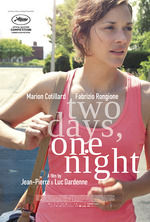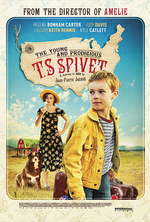Film Screening 16th May, 2015

Two Days, One Night (Deux jours, une nuit)
7:00 PM, 16th May, 2015
- M
- 91 mins
- 2014
- Jean-Pierre Dardenne, Luc Dardenne
- Jean-Pierre Dardenne, Luc Dardenne
- Marion Cotillard, Fabrizio Rongione, Catherine Salée, Baptiste Sornin
The Dardenne brothers are known for their neo-realist films Rosetta and L’Enfant – both Palme d’Or winners. They depict those most vulnerable in society – the unemployed, the poor, the infirm.
In Two Days, One Night the brothers turn their attention to the plight of a working mother and recovering depressive, Sandra (Cotillard). Sandra is a factory worker in a solar-panel factory in a hardscrabble, industrial town of Belgium. She returns to work after a period of illness to discover her co-workers, given the choice of losing their annual bonuses or losing Sandra, have voted in favour of keeping their bonuses.
Sandra is given one weekend – the film’s namesake – to convince her colleagues to reverse their votes. She goes from door to door to plead, to reason and to beg. She is asking each to forego their bonus. Cotillard’s deft performance, her most unglamorous role to date as the deeply vulnerable Sandra desperately trying to restore her dignity by restoring her job, is completely absorbing. Some of these encounters are absolutely heart-wrenching.
The Dardenne brothers give the film a kind of hyper-realism by shooting with handhelds, largely using natural lighting and casting an excellent ensemble. The end result is a compelling, humanist and deeply moving story about our interdependency as a community and the fragile veneer of middle-class life.
Two Days, One Night was the winner of the 2014 Sydney Film Prize and deserves to be seen by a big audience at Coombs.
Andrew Cong

The Young and Prodigious T.S. Spivet (L’extravagant voyage du jeune et prodigieux T.S. Spivet)
8:41 PM, 16th May, 2015
- M
- 105 mins
- 2013
- Jean-Pierre Jeunet
- Jean-Pierre Jeunet, Guillaume Laurant
- Kyle Catlett, Helena Bonham Carter, Judy Davis, Niamh Wilson
This movie has been adapted from the Reif Larsen book. T.S. (Catlett), a ten-year old boy, lives with the rest of his family (parents, older sister and twin brother) on a ranch in Montana, a sparsely populated state in the West of the United States. T.S. is emotionally distant from his mother (Bonham Carter) because she is an obsessive entomologist. Likewise T.S. has little in common with his farmer father (Callum Keith Rennie), because T.S. is a prodigy at science and creating gadgets.
The plot of the movie hinges upon T.S. creating a perpetual motion machine, and being invited to attend the Smithsonian Museum in Washington DC (on the other side of the country) to collect a prize. T.S. cunningly duped the Smithsonian’s prize organiser Ms Jibsen (Davis) into thinking that he is an adult. And then T.S. successfully runs away from home, traversing the continent alone.
If the above plot description didn’t clue you in, the movie belongs to the ‘magic realism’ genre. Sure enough, its director, Jean-Pierre Jeunet, previously made the highly successful magic realism movie Amelie. A note on the cinematography; as with much of Jeunet’s work, the scenes set on the Spivet ranch are beautiful to behold.
Richard Hills